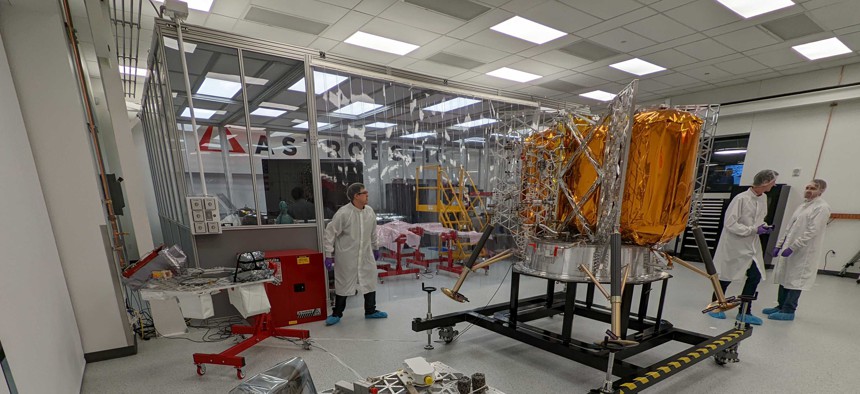One small step for man, one giant leap for Pittsburgh

Photo courtesy of Astrobotic
Steel city startups are set to send new tech to the moon. But Pittsburgh’s galactic ambition doesn’t end there. Local and state officials want to play a key part in the future of America’s space exploration.
Think of the space industry in the U.S., and places like Houston, Cape Canaveral, Florida, or Huntsville, Alabama, likely spring to mind. But how about Pittsburgh?
No? Well, a collection of state and local officials and business leaders from the Keystone State are looking to change that.
The space industry is set to grow dramatically. The sector could be worth as much as $1 trillion worldwide by 2030, according to researchers at McKinsey & Company. And Pittsburgh is hoping to cash in.
Known as the steel-making capital of the world, the Midwestern city of more than 300,000 people wants to join the likes of China and India in flexing its muscles in space. This all is with a view to support the federal government’s goals, like launching satellites for internet and other communications and maintaining its dominance in space. And like NASA, Pittsburgh wants to play its part in helping return people to the Moon and explore Mars.
The Keystone Space Collaborative, a regional organization that works to promote space industry businesses and talent in Ohio, Pennsylvania and West Virginia, announced in June that it would form a space and innovation district in Pittsburgh. The district is intended to be a “space and defense innovation industry cluster,” according to the collaborative, and enable regional economic development.
Earlier that same month, Rick Siger, secretary of the Pennsylvania Department of Community and Economic Development, separately announced that the administration would invest $200,000 to support the regionwide Keystone Space Innovation Challenge, a pilot program to support the design, development, testing, launch, operations and return of suborbital and low Earth orbit experiments.
Siger also announced the expansion of the Greater Oakland Keystone Innovation Zone to include the growing space industry in the north of Pittsburgh. That expansion means companies within the zone can take advantage of annual tax credits.
“By connecting all facets of space, innovation, academia, the economy, our workforce and the general public, we’re positioning this region to be a leader in the global space ecosystem,” said Justine Kasznica, board chair of the Keystone Space Collaborative, following the announcement.
Local officials cite two major reasons for why Pittsburgh is attractive as a space hub: its manufacturing base and a highly skilled workforce developed by top research universities in the city. In addition to the steel industry, the city is home to other industries like health care, computer science, robotics and more.
“We like to say building things has always been in our DNA,” said Matt Smith, chief growth officer at the Allegheny Conference on Community Development, which works to promote economic development throughout southwestern Pennsylvania, including Pittsburgh. “While we have that rich legacy, and we recognize it, we don't rest on that rich legacy.”
Smith said the city’s rich talent pool is a “competitive strength” when building the city’s space sector. Carnegie Mellon University and the University of Pittsburgh both are in the city limits and are top-tier research universities.
What’s more, Pittsburgh’s foray into the space sector has the support of the state’s top official, Gov. Josh Shapiro. Smith said state leadership has shown their support through better licensing and permitting and by encouraging special districts like the Keystone Space Collaborative’s innovation district.
The importance of academia is apparent with the growth of Astrobotic, which company CEO John Thornton said is “Pittsburgh's neighborhood space company.” The company was founded by a group of academics at Carnegie Mellon to win the Google X Lunar Prize that called for privately funded teams to land a lunar rover on the Moon, travel 500 meters, and transmit high-definition video and photos back to Earth.
Astrobotic has gone on to win multimillion dollar contracts with NASA, including a $199.5 million award in 2020 to deliver the Volatiles Investigating Polar Exploration Rover, or VIPER, to the south pole of the Moon. The company also was selected by NASA last month for a $34.6 million investment to demonstrate how robots can deploy one kilometer of cable on the Moon and transmit power through it.
The company has two upcoming lunar missions, with one set to fly in the latter part of this year with 16 cargo payloads from around the world, and the other, VIPER, set to take off next year.
Thornton said Astrobotic officials “shout our story from the rooftops” to encourage other space companies to move to or start up in the city, and also to attract potential workers interested in the sector. But he said the company quickly realized it “needed to do something bigger,” so it created a nonprofit called the Moonshot Museum.
Inside, visitors can see lunar spacecraft being built and learn about both the history and the future of space flight, the Moon, jobs in space and the future of space policy. In less than a year, the museum has had more than 10,000 visitors and been a crucial part of outreach to local schools.
“We're already having an impact, trying to get the word out that space is a part of Pittsburgh's DNA now,” Thornton said.
Officials involved in the push to make Pittsburgh the next great U.S. space hub are optimistic it can be a boon for the city’s economy.
“If Pittsburgh can land on the moon, Pittsburgh can do anything,” Thornton said. “I hope people will use our story for inspiration and to supercharge the next big things in their industries and their lives.”
NEXT STORY: Digital twins: Debunking 4 common myths






